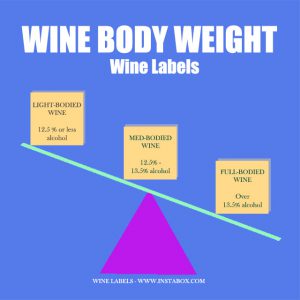8 BEST TIPS TO PAIR WINE LABELS WITH FOOD (SIMPLIFIED)
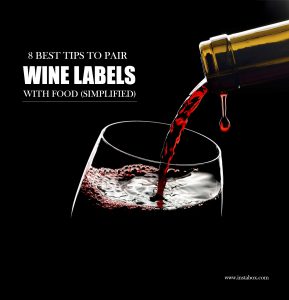
Here are eight best tips to pair wine labels with your favorite dish. Do not let the thousands of wine boxes in the market intimidate you. This is a simplified way to combine your food and wine with ease. Apply these easy steps to eliminate confusion. Let us take a sip and begin.
1. WINE LABELS: KEEP IT SIMPLE
There are many wine labels out there. The key is to keep it simple. Start with the basic of the basics. Pick a favorite wine you truly enjoy. Choose something you would drink by itself as a stand-alone drink. This is a foolproof way to assure that even if your pairing were not perfect, it still would not be a disaster. Just as there are many ways to mix ingredients to create a meal, there are many ways to combine your dish with your wine. The combination is subjective. Wine is a personal experience. “Wine is bottled poetry,” Robert Lewis Stevenson.
To start, distinguish the main types of wine. Second, determine if it is a light-bodied, medium-bodied or full-bodied wine. Learning these differences is the key for easy pairing.
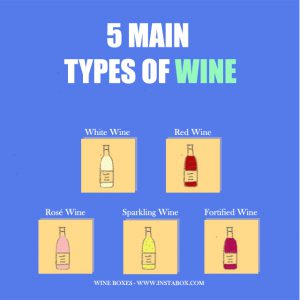 2. WINE BOXES: 5 MAIN TYPES OF WINE
2. WINE BOXES: 5 MAIN TYPES OF WINE
Disregard the plethora of wine boxes that are out in the market. There are generally five main types of wine. They are white wine, red wine, rosé wine, sparkling wine and fortified wine.
White Wine
White wines come from white, yellow, green, and even red grapes. Fermented white wine are without the grape skins. The majority of white wines have a light, zesty, fruity, acidic and fresh clean taste. It is translucent in color with a delicate aroma. White wines are generally light-bodied.
Red Wine
Red wines come from red, black, blue or purple colored grapes. Fermented red wines are with their skins, seeds and sometimes stems. Because of its extended fermentation, they tend to have higher tannins. Tannin in wine adds bitterness, dryness and astringency and can vary in strength.
Red Wine: Light, Medium and Full
Light-bodied red wines are fruity. They have a lighter tannin, bright acidity and red fruit flavors. They tend to grow from cooler climates.
Medium-bodied wines will have medium levels of fruit flavor, tannin and acidity. They still evoke fruit flavors and have transition to the darker fruits. These strong hints include black cherry, plum, blueberry and blackberry.
Full-bodied red wines are savory and richer. They have complex flavors, bold tasting notes, and powerful aroma. Full-bodied wines have intense flavor, dark red in color and dry. Full-bodied wines tend to grow from warmer climates.
Rosé Wine
Rosé wines are also made with red wine grapes but are fermented at a reduced time. Rosé is a dry wine that tastes similar to many white wines. Rosé wines are not sweet. A Rosé also has the fruitiness of the red wine. Rosé comes in many shades of pink, peach, pale orange and near purple. A rosé offers a bright, more refreshing flavor than its deep red counterparts.
Sparkling Wine
Sparkling wines are bubbly and carbonated. They have high levels of carbon dioxide due to secondary fermentation. This contributes to their exciting fizzy characteristics. The infamous loud opening “pop” of a corkscrew comes from the celebrated, sparkly French champagne. Some white wines and rosé wines are also sparkling wine. They can range from being very sweet to very dry.
Fortified Wine
Fortified wines have added distilled spirits, and it is usually brandy. Grape brandy is the most common type of fortified wine. They are viscous or syrupy. They are traditionally sweet red wine that can range from dry to semi-dry styles.
3. WINE BODY WEIGHT
If you know the body weight of the wine, the easier it is to pair it with a meal. A light dish goes well with a light-bodied wine. A heavy dish goes well with a full-bodied wine. The combination should be a heavenly match. Idealistically, the wine should not overpower the dish. The dish should not overpower the wine. It is a beautiful balance. It is a harmonious dance between the two.
How can we know if the wine is light-bodied, medium-bodied or full-bodied? The secret is to look at the alcohol percentage. It is a very easy formula to remember. Low alcohol levels mean light-bodied wines. High alcohol levels mean heavy full-bodied wines. The more alcohol it has, the heavier and viscous it becomes.
Here are the alcohol percentages
Light
Light-bodied wines are under 12.5 % alcohol. Generally, these white wines are crisp and refreshing.
Medium
Medium-bodied wines are between 12.5% to 13.5% alcohol.
FULL
Full-bodied wines have an alcohol content over 13.5%. The majority of heavy-bodied wines are red.
Now that we distinguished the wines in their categories, let us break it down further to the different types of meals.
4. APPETIZERS / HORS D’OEUVRES 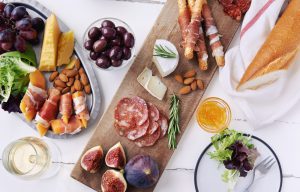
Eliminate the guesswork of pairing wines with your appetizers. When eating hors d’oeuvres, reach for a crisp white wine, sparkling wine or a bright and fruity rosé wine. An appetizer’s purpose is to boost your appetite prior to the main meal. A light mini meal matches perfectly with a light wine. The wine and food should complement one another. What better way to wake up your palate than to accompany it with a crisp white wine, sparkling wine or a refreshing rosé.
5. WHITE WINE FOR LIGHT DISHES
A light-bodied white wine should have the same potency as the dish. Therefore, a light-bodied white wine matches perfectly with light dishes. Most white wines pair easily with a light salad, pasta with light/white sauce, chicken, fish, turkey or pork.
Pay attention to spicy dishes with a lot of black pepper, red peppers, wasabi or jalapeños. To balance off spicy dishes, choose wines that are softer, slightly sweeter, creamier and less acidic in taste. Spicy dishes goes well with wines such as Chardonnay, Riesling, Moscatos or Chenin Blancs.
6. RED WINE FOR HEAVIER DISHES
Keep it effortless. Heavy entrees and red wine are divine. Red wines are intense, bold, rich and savory. Heavy dishes are intense, bold, rich and savory too. They both have the same characteristics. They blend nicely because one is not overpowering the other.
Here are a few dishes that pair well with red wine. A sample includes hard cheese, prime rib, red meat, T-bone steaks, pasta with red tomato sauce, filet mignon, barbecue chicken, grilled steak, or hearty stew.
7. VERSATILE SPARKLING WINE
Sparkling wines are not only bubbly and fizzy, but they are also very versatile. Sparkling wine is a good palate cleanser. They go perfect with anything salty. They also compliment fruit-based or buttery desserts very easily.
Some sparkling wine include French Champagne, Italian Prosecco and Spanish Cava. Sparkling wines marries well with shrimp, smoked salmon, shellfish, soft-cheese, tarts, crepes, cheesecake, and shortbread cookies.
8. FORTIFIED WINE
Savored as a before or after dinner drink, the added distilled spirits in fortified wine gives it its unique syrupy taste. Fortified wines are often termed as a dessert wine. It pairs perfectly with nuts, cheese, fruit tarts and chocolate-based desserts. They also make a great cooking wine.
The most common fortified wines are Marsala, Madeira, Port, Sherry, Vermouth and Commandaria wine.
CONCLUSION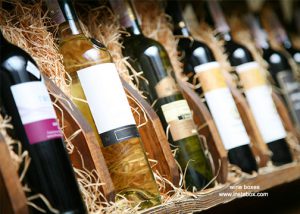
Knowing the simple five categories of wine and the three-body type of wines is an easy way to gauge how to pair it with your favorite dish.
ONE STEP FURTHER
If you decide to deepen your knowledge, there are many expert advices from professional sommeliers, books and articles.
Perhaps you would like to explore a few tasting rooms and wineries. There are many famous wineries in Italy, France, Portugal and America. Unbelievably, there are also many wineries in Canada. If you should happen to be here in Canada, come see the beautiful wineries in Kelowna, Penticton, Osoyoos BC, and Kamloops BC. Fine-tune your wine pairing craft as you expand your palate’s taste for fine wine and dining. Saluti! Salud! À votre santé ! Cheers!


